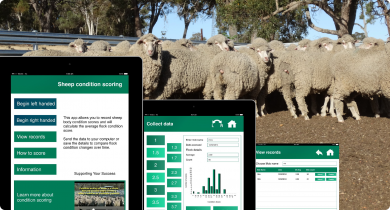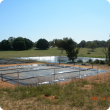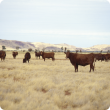Livestock management
Management of livestock must take into account variable seasonal factors, fluctuating markets and declining terms of trade. The most successful producers have a good knowledge of market requirements, matching product quality to suit. There are many factors that can determine the productivity and profitability of a livestock enterprise. These include the supply and quality of feedstuffs, the use of the most appropriate genetics, ensuring high health standards, optimising housing or environmental conditions, meeting quality assurance requirements, and having a sound knowledge of market requirements. This requires good communication along the value chain.
The Department of Primary Industries and Regional Development has technical expertise in a range of areas related to livestock management but acknowledges that there are many other sources of information that producers should be encouraged to seek out. There are many grower groups who play an important role in encouraging discussion amongst producers to improve adoption of new technology, as do private consultants and university scientists.
See Also
Articles
Pages
Filter by search
Filter by topic
- (-) Remove Climate, land & water filter Climate, land & water
- (-) Remove Climate & weather filter Climate & weather
- Climate change (10) Apply Climate change filter
- Crops (6) Apply Crops filter
- Grains (5) Apply Grains filter
- Feeding & nutrition (5) Apply Feeding & nutrition filter
- Rangelands (3) Apply Rangelands filter
- Livestock research & development (3) Apply Livestock research & development filter
- Land use (3) Apply Land use filter
- Dry seasons and drought (3) Apply Dry seasons and drought filter
- Production & postharvest (2) Apply Production & postharvest filter
- Livestock species (2) Apply Livestock species filter
- Genetics & selection (2) Apply Genetics & selection filter
- Animal welfare (2) Apply Animal welfare filter
- Pests, weeds & diseases (1) Apply Pests, weeds & diseases filter
- Pastures (1) Apply Pastures filter
- Pasture management (1) Apply Pasture management filter
- Measuring and assessing soils (1) Apply Measuring and assessing soils filter
- Sheep (1) Apply Sheep filter
- Soil management (1) Apply Soil management filter
- Water management (1) Apply Water management filter
- Water (1) Apply Water filter
- Soils (1) Apply Soils filter
- Management & reproduction (1) Apply Management & reproduction filter
- Wheat (1) Apply Wheat filter
- Carbon farming (1) Apply Carbon farming filter
- Canola (1) Apply Canola filter
- Biosecurity & quarantine (1) Apply Biosecurity & quarantine filter
- Biosecurity (1) Apply Biosecurity filter
- Beef cattle (1) Apply Beef cattle filter
- Fire (1) Apply Fire filter
- Grains Research & Development (1) Apply Grains Research & Development filter
- Livestock biosecurity (1) Apply Livestock biosecurity filter
- Liming (1) Apply Liming filter
- Irrigated crops (1) Apply Irrigated crops filter
- Horticulture (1) Apply Horticulture filter
- Livestock movement & identification (1) Apply Livestock movement & identification filter






